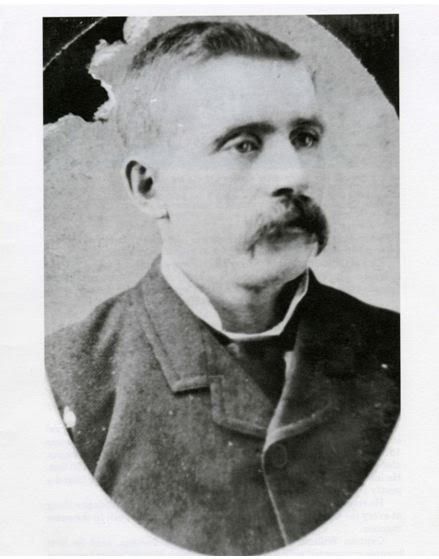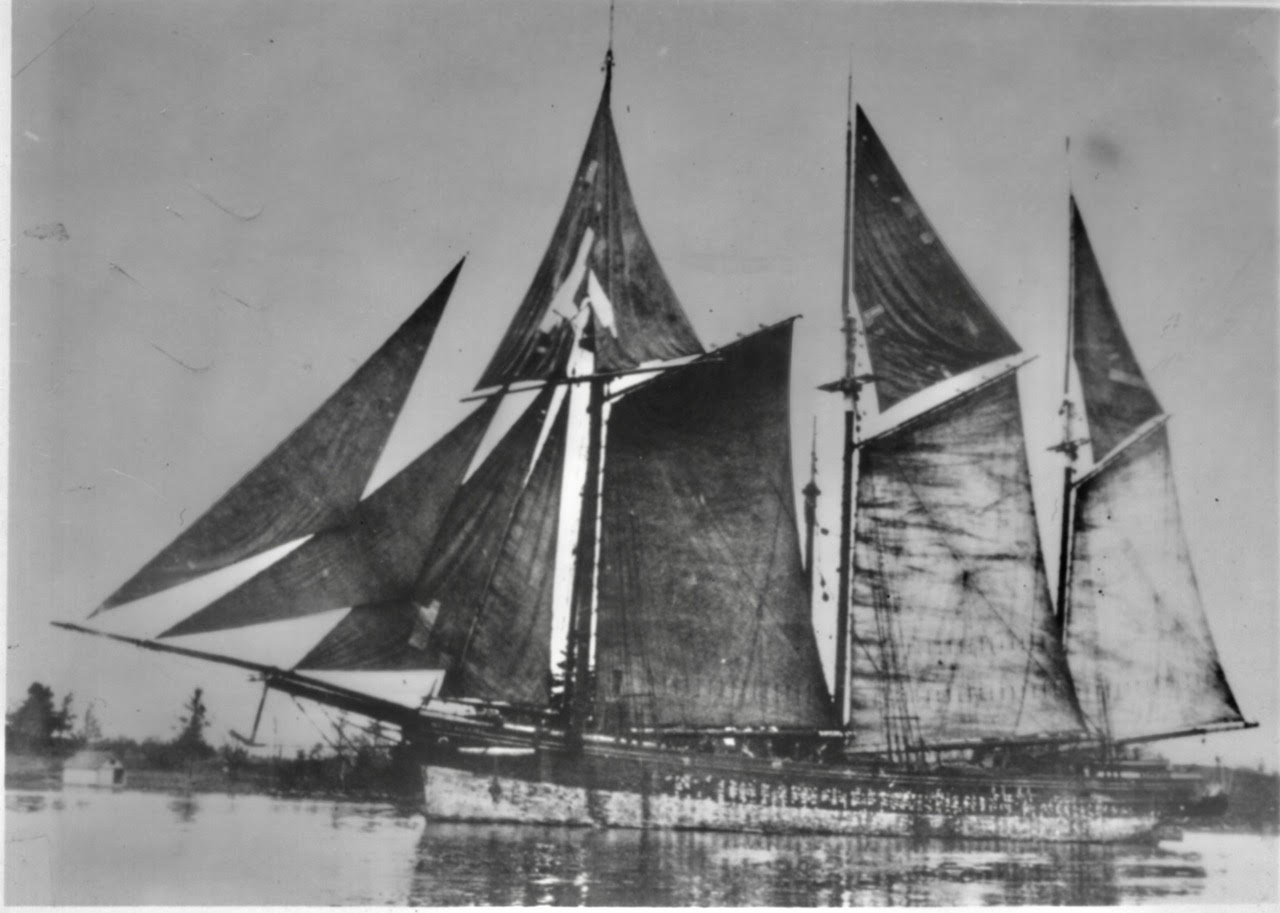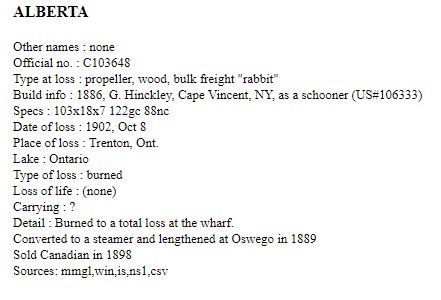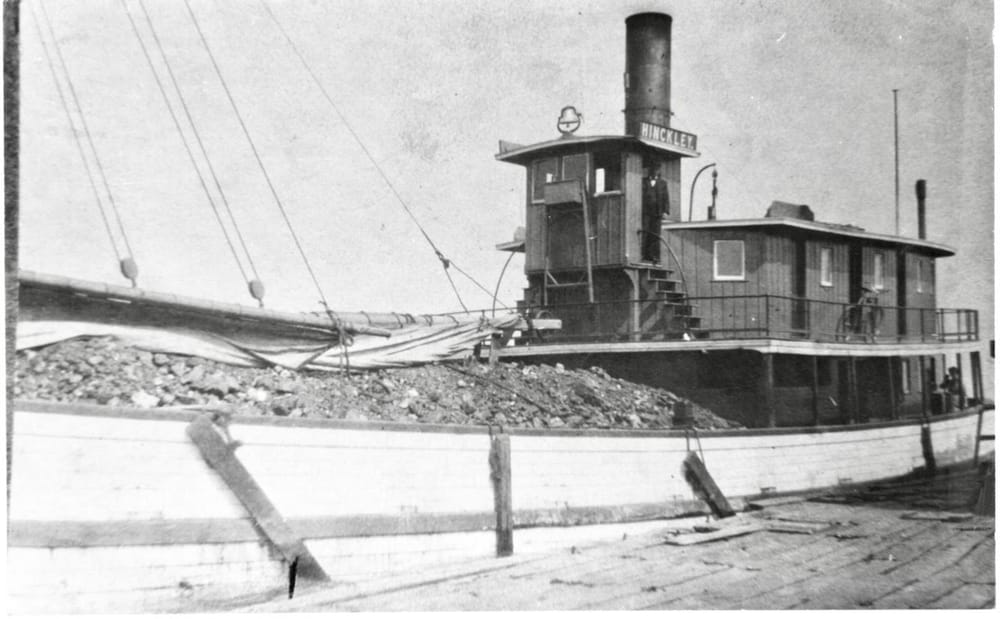An Augustus Hinckley Story
by: Richard Palmer
Augustus Hinckley, known as Gus, came from a long line of mariners. His grandfather, Samuel was granted a license to run a ferry between Wolfe Island and Kingston beginning in the 1820s and his father, Coleman Hinckley, piloted steamboats up and down the St. Lawrence River for many years. By the end of Gus Hinckley's career he had his own fleet of ships, as well as a government contract to place buoys in the St. Lawrence River between Cape Vincent and Morristown. In addition, his skill as a salvager in retrieving sunken ships won him wide renown.

Over the next three issues we will describe some of Gus Hinckley's most exciting voyages, as well as providing more of his biography.
The Alberta
One of Captain Hinckley's first vessels was an old schooner called the Alberta. The origin of this ship is somewhat hazy, although official records state it was built by Hinckley at Cape Vincent in 1885. It was named after a young lady who, it has been said, was the Queen of Simcoe Island, which lies about three miles south of Kingston. Another account states it was built during the winter of 1890 at Kingston and was a largish hooker-style ship similar to the barrel-bowed John Wesley.

The Alberta was 98-feet in length, with a round barrel bow and a square sawed-off stern, 18.1 foot beam and a seven foot depth, weighing 88 gross tons. (US #106355, Canadian #103648). She carried plenty of canvas and was considered fast for a vessel in her class. After being used as a sailing vessel or stone hooker for several seasons, Hinckley decided to rebuild her as a steam barge. He added some 18-feet to her bow and made her sheer the same as other steamboats, also adding a round stern, which increased her length to about 130 feet. He installed a boiler and engine, cabins, etc., and she was considered a pretty fair little steam barge.
Hinckley retained the foremast and used the canvas to help push her along at every favorable wind. Most of his later vessels were built in the same manner. Captain William Stitt, master mariner of Toronto, said he first became acquainted with the vessel in the spring of 1899, “When I engaged with Capt. Hinckley as her master to trade between Coteau Landing, P. Q., and Montreal for the Canadian Atlantic Railway in the grain, flour and package freight trades and we also towed one of the old K & P barges loaded with grain on this route each trip.
“On our easterly run we took grain, flour and package freight and on our westerly run iron, steel, cement and every class of freight for the Northwest. This was a year before the Soulanges Canal was opened and we were using the old Bauharnois Canal on the south side of the river, with its western entrance at Valleyfield. This canal was 13 miles long and had nine locks, 200 feet in length and carried only nine feet depth for navigation. The Coteau Landing Harbor was dredged out of the beach just east of the government pier with a lighthouse on the end of it.
“The basin was dredged in a north direction from deep water for 1,800 feet, and a width of 400 feet with freight sheds on one side and a grain elevator on the other side. Railway tracks ran from the yards down to and alongside both sheds and elevator. It was a most modern and up-to-date terminal. The Coteau Landing Terminals commenced about the year 1895, were finished in the fall of 1899. After the Soulanges Canal was finished in 1900 and also the other St. Lawrence canals and channels were deepened to 14-foot navigation and vessels could come right through from the Great Lakes without lightering, and about that time the Canadian Atlantic was absorbed by the Canadian National Railways, so Coteau Landing terminals were closed down as they were not needed. The completed harbor only had a life of one year.
“The C.N.R. had their own terminals in Montreal, so the harbor was scrapped, the elevator and freight sheds taken down, railway sidings and yard cleared of the steel and buildings and nothing remained of what was once a beehive of activity day and night. The life of the terminal was short, only five years from start to finish.
“About Oct.15, (1899) we left the Coteau-Montreal run and went in the coal trade between Lake Ontario ports, Bay of Quinte and the St. Lawrence river for the balance of the season. In November the steam barge was in Oswego loading hard coal for Kingston. Weather had been fine since commencement of the lake trade. We had two nice runs from Charlotte to Bay of Quinte ports and it was fine and calm and everything pointed to another fine run that night to Kingston. After trimming the hold full and battening the hatches down we ran 75 tons of grate coal on deck which left us with about a foot of freeboard.”
Loading ships to the point of being overloaded was one of Captain Hinckley's practices which often got him into trouble and lost him his vessels. Stitt said, "while the mate and crew were making the boat ready for sailing about 4 p.m. I went into the custom house to get my clearance, and on the way ran into a Mr. Clarke, who was shed foreman at the Coteau terminal when we traded there. He had returned home to Kingston the week before, and with his wife and baby had come over to Oswego to visit some relatives. When I told him we were loaded for Kingston he wanted to know if they could ride over with us. The weather seemed perfect so I consented and told him to get his wife and baby and join us at the New York, Ontario & Western trestle.
“When I returned from uptown, friend Clarke and family were on board, so I gave them my room for the trip over. It was just 6 p.m., when we were passing out the piers and the cook ringing the supper bell when we saw one of the men from the lifesaving station raising the storm signal for a strong nor'easter. The lake was as calm as a pane of glass, but the seagulls were all in on the breakwater, a sure sign of dirty weather, and our ship's barometer was also going down. But it's only 28 miles to Stony Point and 30 miles to the Galloo Island, the Big Galloo and the Little Galloo, about four hours run and we could find shelter if necessary. We didn't want to go back and get caught in Oswego for two days and sometimes a week at this time of year. I have seen 60 vessels stormbound there for over a week.
“It's a nasty place to get out of when the wind blows off the lake. So we stood on. At 8 p.m. when on our course to Galloo and Kingston, and about 16 miles out of Oswego, it became intensely dark and some light snow began falling. We had lost sight of all light for the past hour, and there was considerable dead roll from the north, which always precedes a storm on the lake.
“At 8:30 a terrific gale from the northeast hit us, accompanied by hail and snow, and it was impossible to look into it. It fairly lifted the water off the lake, and in less than 10 minutes heavy seas were washing right over the vessel. All these steam barges at that time were fitted with a heavy mast forward, used for hoisting the cargoes from the hold and also for the foresail, and when not in use these were furled up and lashed to the booms and lowered down to within five or six feet of the deck."
“In bad weather a life line was run from the mast to the railing forward of the pilot house, which was always aft on these small steam barges. This was the way the crew got forward and kept out of the heavy seas washing over the deck and got protection behind the turtle deck forward where the sounding pipe ran down to the keelson. Even at that it was a dangerous job in heavy weather. Now, while the storm is at its worst outside, let us look inside of the cabins and in the fire-hold and engine room.
“All the crew, except the chief engineer, Jack Barber, myself and my passenger, Mr. Clarke, had gone down with seasickness early in the storm. They were laid out everywhere and dead to the world and I guess didn't care if the ship did go down. Mrs. Clarke was deathly sick, but the baby slept through it all. The cabin furniture was strewn all over and many pieces broken, and it kept Mr. Clarke busy keeping his wife and baby from rolling out of the berth. The Irish cook was mixed up with pots and pans behind the stove which remained solid, being bolted to the floor, but everything else in the kitchen and dining room was torn down and in most cases broken. The cook resembled Dinah, of pancake flour fame, for the soot from the stove and pipes had given her a fine coat of ebony.
“But the big fight was being waged down in the engine room and fire-hold. Chief Barber, up to his knees in water in the fire-hold, was fighting away to make enough steam to keep the water down and prevent it putting the fires out, which would mean Davy Jones' locker for all of us. It was impossible to keep over 60 lbs. of steam, and with our deck awash things looked pretty black. I was about as busy as the chief trying to hold the ship head-on, and holding myself when she took those awful rolls and lunges in those big whitecap seas that every once in a while lifted the ship almost on end. Minutes were like hours during the height of the gale, and the night seemed endless.
“I had seen thousands of lights in my imagination during the night for I knew we were pointing towards the grand old Galloo Light that has guided so many mariners across in some pretty tough weather—and many lost, too—but while there's life there's hope. I was in constant touch with the chief engineer by speaking tube. At 4:15 in the morning it was blowing just as hard and snowing, and black as ink, but the sea was going down and I knew we were coming under the island and called to the engineer and told him to keep the good work up and we would soon get shelter. He said the water was almost in the furnaces."
“I turned back to the wheel again and to my joy there was the grand old Galloo Light—and the fog whistle—and in less than two minutes we were grounded in the southwest side of Galloo island on the sand beach. It's surprising how quickly the crew came to when they saw terra firma, and got busy on the pumps, and at 9 a.m. we floated off the bottom and repaired our storm-battered hulk as best we could, and as the wind and snow died away in the afternoon we ran down through the Stony Island channel and out by Grenadier and across the head of Wolfe Island to the Batteau Channel, and arrived in Kingston early the following morning."
“We saved all the cargo below deck, but lost the 75 tons on deck and both our lifeboats. All the crew soon came to, but Mrs. Clarke, who was a blonde when she came on board at Oswego, left the boat at Kingston with many ‘silver threads among the gold.’ I parted company with the Alberta that same fall, but I heard after that she burned and was beached at almost the same spot on Galloo Island that we landed on that stormy trip."

The Alberta was destroyed by fire, but while lying at the wharf at Trenton on Oct. 8, 1902. The vessel had first been registered at Kingston by Hinckley, then of Cape Vincent, on April 21, 1899. On Oct. 25, 1901 she was sold to Amanda Smith of Belleville.
By Richard Palmer
[printed in part in The Crooked Lake Review, summer 2003.]






Please click here if you are unable to post your comment.